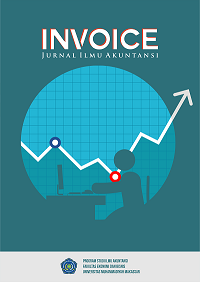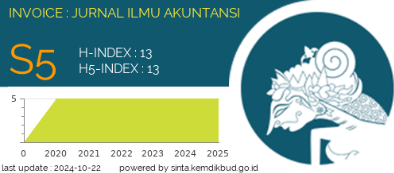Impact of Inflation, Forex Reserves, and Exchange Rates on the Composite Stock Price Index of Manufacturing Firms in Indonesia
Abstract
This study aims to analyze the influence of macroeconomic factors, namely inflation, foreign exchange reserves, and exchange rates, on the Composite Stock Price Index (IHSG) in Indonesia. The study utilizes secondary data, including IHSG, inflation rates, foreign exchange reserves, and exchange rate fluctuations on the Indonesia Stock Exchange (IDX), and employs multiple linear regression analysis to assess the relationships among these variables. The research adopts a descriptive quantitative approach to systematically describe and interpret the data. The findings reveal that inflation has a positive and significant impact on IHSG, suggesting that rising inflation can stimulate stock market performance under certain conditions. Likewise, the exchange rate demonstrates a positive correlation with IHSG, indicating that currency appreciation may enhance investor confidence and stock price growth. Furthermore, foreign exchange reserves are positively associated with IHSG, reflecting the stabilizing effect of a strong reserve position on financial markets. These results align with existing financial theories that highlight the interconnectedness of macroeconomic stability and stock market performance. The study provides valuable insights for investors, policymakers, and market analysts regarding the macroeconomic determinants of stock market movements. Future research is encouraged to expand the scope by incorporating additional variables, such as interest rates, monetary policy interventions, and global economic trends, to further enhance the understanding of factors influencing IHSG dynamics.References
Bibliography
Ahmad. (2004). Influence of Inflation, Interest Rates, and Exchange Rates on the Composite Stock Price Index on the Indonesia Stock Exchange.
Atik, Y. (2011). Influence of Inflation, Exchange Rates, and SBI Interest Rates on Stock Prices Listed on the Indonesia Stock Exchange (IDX).
Bayu, W. (2003). Effects of Dynamic Disturbances in Aggregate Demand and Supply on Inflation Fluctuations in Indonesia. Journal of Economics and Business (Dian Ekonomi), 2(1).
Bernanke, B. S., & Kuttner, K. N. (2004). What Explains the Stock Market's Reaction to Federal Reserve Policy? Journal of Finance.
Budilaksono. (2005). Influence of Inflation, Interest Rates, and Exchange Rates on the Composite Stock Price Index on the Indonesia Stock Exchange.
Jatiningsih, O., & Musdholifah. (2007). The Influence of Macroeconomic Variables on the Composite Stock Price Index at the IDX. Journal of Applied Management, 5(1), April.
Kristiyawati. (2011). Analysis of the Influence of SBI Interest Rates, Exchange Rates, Money Supply, and the DOW JONES Index on the Composite Stock Price Index (IHSG) on the Indonesia Stock Exchange (IDX).
Muzammil, A. (2011). Analysis of the Influence of the Southeast Asian Stock Index on the Composite Stock Price Index (IHSG) on the Indonesia Stock Exchange.
Niken, R., & Muhaimin. (2011). The Influence of the Dow Jones Industrial Average (DJIA) Index, Inflation, Rupiah Exchange Rate, and Foreign Exchange Reserves on the Composite Stock Price Index (IHSG) (2008–2010).
Novianto, A. (2011). Analysis of the Influence of the US Dollar/Rupiah Exchange Rate (US$/Rp), SBI Interest Rate, Inflation, and Money Supply (M2) on the Composite Stock Price Index (IHSG) on the Indonesia Stock Exchange (IDX) (1999.1–2010.6).
Octaviana, A. (2007). Analysis of the Influence of the Rupiah/US$ Exchange Rate and SBI Interest Rate on the Composite Stock Price Index at the Jakarta Stock Exchange.
Pinem, J. R. (2009). Analysis of the Influence of Exports, Imports, and the Rupiah Exchange Rate on Indonesia's Foreign Exchange Reserves.
Purba, B. (2013). Analysis of the Influence of GDP Growth, SBI Interest Rates, CPI, Foreign Exchange Reserves, and Rupiah Exchange Rate on the Growth of Money Supply in Indonesia.
Raharjo, S. (2009). Analysis of the Influence of Macro Variables and Financial Ratios on Stock Prices in Manufacturing Companies at the Indonesia Stock Exchange.
Valadkhani, A., Chancharat, S., & Harvie, C. (2006). The Interplay Between the Thai and Several Other International Stock Markets. Working Paper 06-18, Department of Economics, University of Wollongong.
Books:
Dumairy. (1999). Ekonomi Indonesia (4th ed.). Jakarta: Erlangga.
Husnan, S. (2001). Basic Theory of Portfolio and Securities Analysis (3rd ed.). Yogyakarta: AMP YKPN.
Kasmir. (2008). Banks and Other Financial Institutions (Revised ed.). Jakarta: Raja Grafindo Persada.
Lipsey, R. G. (1990). Macroeconomics. New York: Harper & Row.
Mankiw, N. G. (2006). Macroeconomic Theory (4th ed.). Jakarta: Salemba Empat.
Samuelson, P. A., & Nordhaus, W. D. (1999). Macroeconomics (14th ed.). Jakarta: McGraw-Hill.
Susilo, S., & Triandaru, S. (2000). Banks and Other Financial Institutions (1st ed.). Jakarta: Salemba Empat.
Online Sources:
Gunadarma University Repository. (2013). Journal article. Retrieved November 2, 2013, from http://repository.gunadarma.ac.id/bitstream/123456789/5255/1/jurnal.pdf
Diponegoro University Repository. (2013). Thesis journal. Retrieved November 2, 2013, from http://eprints.undip.ac.id/27812/1/JURNAL_SKRIPSI.pdf
Riau University Repository. (2013). Journal article. Retrieved November 2, 2013, from http://repository.unri.ac.id/bitstream/123456789/651/1/JURNAL%20ARYUNI%20INTAN%200802113111.pdf
Jejong. (2013). Pengertian Kurs dan Macam-Macam Kurs. Retrieved November 21, 2013, from http://jejong.wordpress.com/2013/06/29/pengertian-kurs-dan-macam-macam-kurs/
Taufieq Hiedaeyat. (2013). Personal blog. Retrieved November 21, 2013, from http://taufieqhiedaeyat.blogspot.com/
Downloads
Published
Issue
Section
License
Authors who publish with Invoice: Jurnal Ilmu Akuntansi agree to the following terms:
-
Copyright Ownership
The copyright of all articles published in this journal remains with the author(s). However, the authors grant Invoice: Jurnal Ilmu Akuntansi the right of first publication with the work simultaneously licensed under a Creative Commons Attribution 4.0 International License (CC BY 4.0). This license allows others to share, copy, redistribute, adapt, and build upon the work for any purpose, even commercially, as long as proper credit is given to the original author(s) and the source. -
Licensing and Access
Invoice: Jurnal Ilmu Akuntansi provides immediate open access to its content on the principle that making research freely available to the public supports a greater global exchange of knowledge. All published materials are available freely without subscription or payment and can be accessed, downloaded, and reused by any user provided that appropriate attribution is given. -
Permission for Reuse
For uses not covered by the CC BY 4.0 license, such as commercial reprints, translations, or any form of adaptation without clear attribution, users must obtain written permission from the editorial team. Requests for such permissions can be directed to the editorial office at: [invoice@unismuh.ac.id]. -
Plagiarism and Originality
Authors are responsible for the originality of their submissions. All articles are screened for plagiarism using appropriate tools before acceptance. Manuscripts found to contain unoriginal content or infringing materials will be rejected or retracted as per journal policy.














